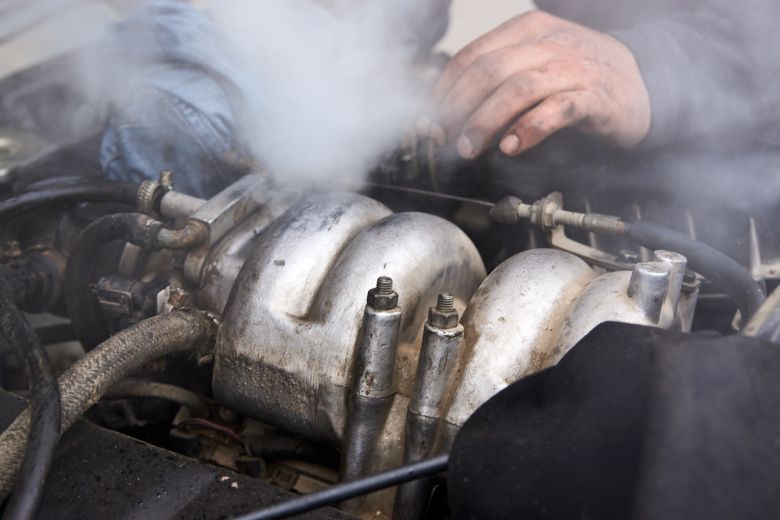If your car is emitting smoke when it's stationary or accelerating then you shouldn't ignore the problem. A smoky car may indicate a serious mechanic problem, but this is not always the case.
Here, we run through some of the most common causes behind the a smoky car or van and what you should do to fix it.
My car is smoking – what should I do?
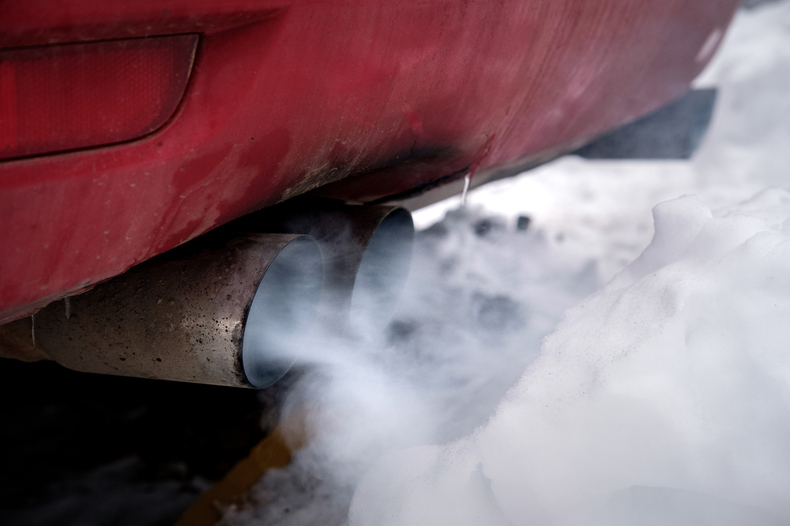
There are numerous reasons why your car could be giving off smoke. Some of the most common causes include:
- leaking head gaskets
- defective coolant systems
- burnt electrical wires
- worn pistons
- faulty fuel valves
To work out what’s causing the smoke, check:
- where the smoke is coming from
- the colour of the smoke
- when the smoke appears
- if your car is overheating
You might find that the clouds aren’t smoke at all, but water vapour condensing on a cold day.
But if you’re sure the smoke is the result of a fault in your car, you should try to identify the problem.
If the smoke appears to be a result of a fire under your bonnet, you should act quickly.
- Turn off your engine
- Pull the bonnet release lever but do not try to prop it open
- Get everyone out of the car and keep your distance
- Dial 999 and ask for the fire service
- Warn oncoming traffic, if it’s safe to do so
The sections below are divided by car parts and the colour of smoke to help you find and fix any faults.

RAC sale – up to 33% off*
• Roadside cover from £5.29 a month†
• We get to most breakdowns in 60 mins or less
• Our patrols fix 4/5 breakdowns on the spot

Different colours of engine smoke and what they all mean
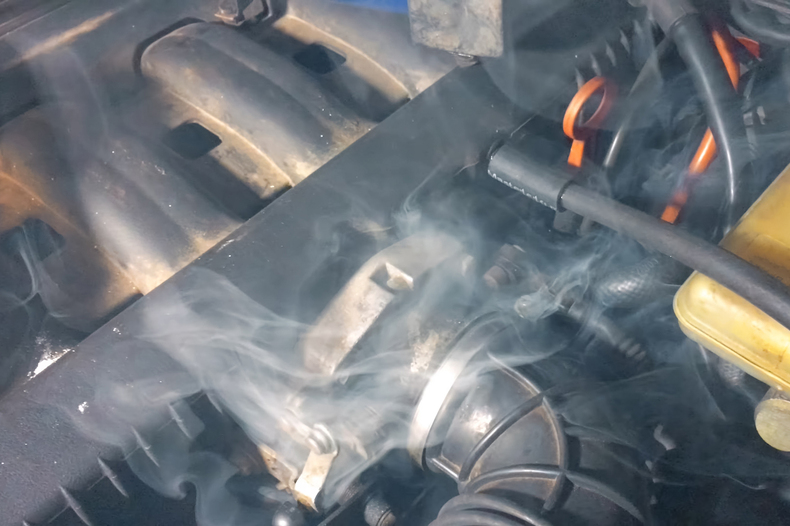
Smoke often leaves car engines as a result of overheating. This can be caused by faulty wire casings, heated residues on the engine block and overheated liquids including oil, transmission fluid and brake fluid.
There may also be a fault in your coolant system, or your engine may not have enough lubricant. No matter the problem, you should find a trusted garage to take a look.
Find an RAC Approved Garage to help.
Are you experiencing a car fault, warning, or mechanical problem on your road trip? Find a local mechanic with the RAC.
Black engine smoke
Black smoke leaving your engine is often a sign that too much fuel is being burned. It could also be caused by a clogged air filter. If you catch either fault early, they are usually easy to fix.
1. Faulty fuel injector
Fuel injectors deliver petrol or diesel into the engine as a high-pressure mist. They can become clogged up with dirt or low-quality fuel, or leak because of wear and tear to the seals.
Both the seals and injector itself can be replaced by a qualified mechanic.
2. Damaged fuel pressure regulator
Just as the name suggests, this part of the fuelling system regulates the pressure of petrol and diesel being fed to your car.
The part can be found either outside or inside the fuel tank and this will affect the cost of a replacement.
You should check with your local garage if the fuel pump needs to be replaced at the same time.
3. Dysfunctional carburettor
Older cars use a carburettor to mix air and fuel. When the part fails and delivers too much petrol or diesel to the engine you’ll notice dark smoke.
It’s important to get the problem checked as soon as possible by a professional, as your car will be burning too much fuel and therefore producing excessive emissions.
4. Blocked inlet manifold
The inlet manifold supplies a mixture of fuel and air to cylinders in the engine.
A blocked inlet manifold will only allow a limited amount of the mixture to the combustion system, which can cause your engine to cough up a cloud of dirty smoke.
Although this part can be cleaned at home, it’s best to enlist the help of a professional if you’re not sure what you’re doing.
5. Ignition timing is off
In order to burn properly, fuel must be ignited at the right time during the combustion cycle.
When your ignition timing is off, your engine will burn more fuel than necessary and in extreme cases pump out clouds of black smoke.
If you think your car is using excessive fuel you should have the engine looked at by a trusted mechanic.
White engine smoke
White smoke from your engine is usually a sign that you have a coolant leak. It could be caused by any one of the following problems:
1. Damaged coolant/radiator hoses
Hoses to and from your radiator can collapse, swell and crack over time and you may be able to see the damage for yourself by simply lifting the bonnet.
The parts should be inexpensive to replace and the work is best carried out by a professional.
2. Cracked engine block
Engine blocks hold all the major parts of your engine together.
Extremely low temperatures can lead to coolant freezing and pushing against the walls of the block causing small cracks.
Although uncommon, manufacturing faults can mean some sections of engine blocks may be thinner than others and more vulnerable to damage.
You can try using an engine block sealer for smaller cracks but will need to visit a trusted garage for anything more serious.
A mechanic may need to re-weld parts of the block or use a method known as cold metal stitching to make repairs.
Be warned, the work is very expensive and it could work out cheaper to buy a new car.
Different colours of exhaust smoke and what they all mean
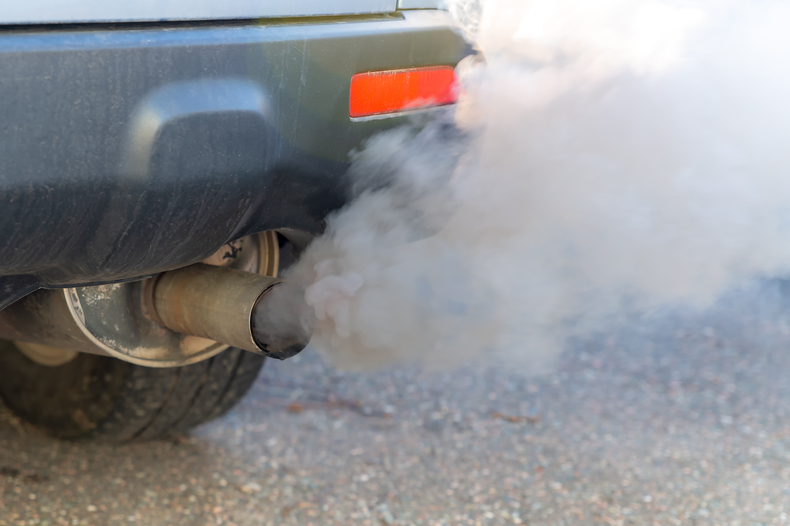
Smoke from the exhaust is usually less serious than smoke leaving the engine.
The colour of the clouds leaving your tailpipe can even help you diagnose the problem elsewhere in your car.
Black exhaust smoke
It’s quite common for cars to give off black smoke from the exhaust when the engine starts up, but if this quickly clears up you should have nothing to worry about.
If the problem persists, your car could be facing one of three problems:
1. Dirty or clogged air filter
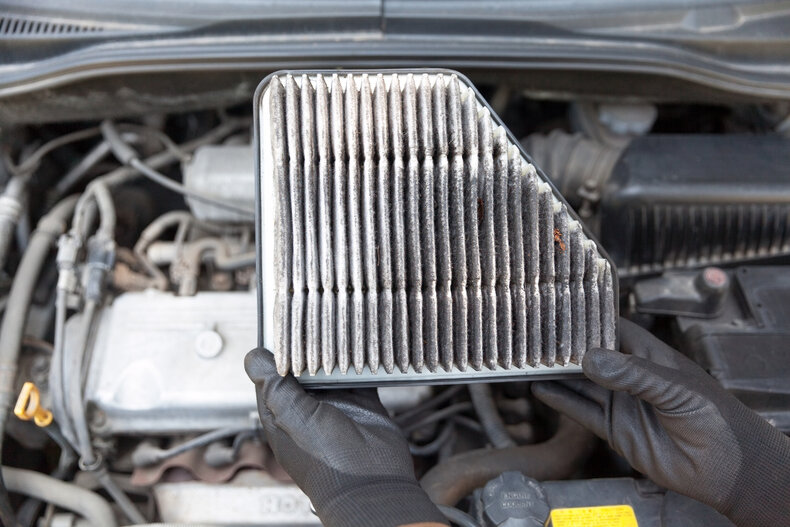
Your air filter prevents unwanted debris from being sucked into your car’s engine. Contaminants collect in the filter over time and prevent the filter from working properly. In some cases the filter can also become damaged.
If debris reaches the combustion engine it can be burned along with fuel and escape as black smoke.
Thankfully, a filter replacement is a straightforward job which you can do yourself, or get a garage to do quickly for you.
2. Bad fuel pressure regulator
If your exhaust continues to give off black smoke, your pressure regulator may be faulty. These devices are used to maintain pressure in the fuel system and are usually mounted on the fuel rail.
A faulty regulator can increase pressure in the system and your car’s fuel economy will suffer greatly. In some cases the excess fuel will burn as black smoke.
The RAC Approved Garage network is a great place to search for a professional who can replace the fuel pressure regulator.
3. Leaking or clogged fuel injector
Fuel injectors control the amount of fuel delivered to the combustion chamber. When the parts go bad, you might notice your car shakes when the engine is idle. If the injectors deliver too much fuel, the excess will often burn as black smoke.
It could be a sign that the parts need to be replaced.
Car playing up?
Get quality repairs at a fair price, plus a 12 month warranty with RAC Approved Garages.


White exhaust smoke
You may notice white smoke leaving your exhaust when you start the engine.
If it quickly disappears, this is usually the result of condensation build up rather than a sign of a more serious problem.
However, if white smoke is visible long after starting your car, your engine is probably burning coolant that has leaked into the combustion chamber. This can happen in three ways:
1. Blown head gasket
The head gasket seals the internal combustion process and keeps coolant and oil from mixing together.
A perforation to your gasket or a blown head gasket usually occurs as a result of an overheated engine. When coolant flows into the combustion chamber from a blown head gasket it burns/evaporates into white smoke.
Check the underside of your oil filler cap. If oil is mixing with water in your engine, there will be a creamy, light-brown deposit on it.
You could try using head gasket sealer to fill out small cracks but more extensive damage will need the help of a professional. Be prepared to pay anything between £500–£1,000 for the repair bill.
2. Cracked engine block
A cracked engine block is almost impossible to repair. The parts are vital to the running of your car and support a number of key components.
Coolant can leak through the cracks and burn as white smoke from hot points in the engine bay.
You’re better off replacing an engine block entirely, but may want to consider cutting your losses and buying a new car instead.
3. Damaged cylinder heads
Cylinder heads sit on top of the engine block to form the combustion chamber. The parts can become warped through overheating and cause your engine to misfire.
When the air-tight seal is lost, coolant can slip through openings and burn as white smoke.
Because the heads have to fit perfectly with connecting parts, you’ll normally have to replace cylinders rather than repair them.
You can find an RAC Approved Garage to help.
Grey exhaust smoke
A thick grey cloud from your exhaust pipe is usually a sign that your car is burning oil.
Once oil escapes it can burn off as grey smoke from various hot points around the engine.
The liquid can leak into your combustion chamber, leading to reduced fuel economy and eventually, damage to your catalytic converter.
The leaking oil can occur for one of two reasons:
1. Malfunctioning valve stem seal
Valve stem seals lubricate the valve in combustion engines to help maintain the correct ratio of fuel and air. When the parts become loose the seal is lost and oil can leak.
Fixing the problem can be complicated and expensive and you may need to rebuild or replace the engine, so you’ll need a trusted mechanic for the job.
2. Failed piston rings
If bluey-grey smoke leaves your exhaust while your vehicle is accelerating, this is usually the tell-tale sign of damaged piston rings. The parts are found in cylinders and can leak oil when they lose their seal.
The fault is uncommon and will need the help of a professional to fix.
Blue exhaust smoke
Bluey/dark grey smoke is a clear sign that your engine is burning oil. The liquid can leak into the combustion chamber where it is burned along with fuel.
You’ll probably notice your car misfiring when you turn the keys in your ignition, or find your vehicle shakes more than usual when idle.
Since blue and grey smoke coming from your exhaust can point to the same faults, there is naturally a bit of overlap with the above section. These leaks are caused by:
1. Worn pistons and piston rings
Pistons use rings to keep an air tight seal in the cylinders of a combustion engine. After some wear and tear, the rings can leak oil into fuel which eventually burns as blue smoke. Although this usually escapes from the exhaust it can appear from the bonnet too.
Damage to the pistons and piston rings is extremely complicated to fix and we recommend taking your car to an RAC approved garage to make sure repairs are done properly.
2. Damaged valve stem seals
Valves regulate the amount of fuel and air mixture allowed into cylinders for combustion. Although their seals are usually made from high-strength rubber, they can become cracked and worn by extreme temperatures or wear and tear.
Mechanics will often use special tools to compress the valve spring before replacing a valve seal.
3. Malfunctioning PCV valve
A PCV valve or Positive Crankcase Ventilation valve releases exhaust gas and unburned fuel from the engine block.
If the PCV valve gets stuck, it will mix oil, air and other gases inside the engine. The combustion of this mixture will cause blue smoke.
Fixing a PCV valve shouldn’t be too costly and usually involves a replacement rather than a repair job.
4. Worn engine oil seals
As oil travels from the tank around the engine it relies on a number of seals to prevent it from leaking to other areas of the car. These seals can suffer from wear and tear, leading to leaks and oil burning off as blue smoke.
If you notice any blue smoke or oil spillages, visit a trusted garage as soon as possible.
5. Inlet manifold leaks
The inlet manifold supplies a mixture of fuel and air to cylinders in the engine. If the manifold leaks oil into the cylinders, this can burn as blue smoke.
Sealants are available to help patch up small leaks but may only work as a temporary fix. Enlisting the help of a professional is always your best option.
6. Head gasket failure
Head gaskets are responsible for sealing the internal combustion process and can become damaged through overheating, allowing oil into different parts of the engine.
You could try a head gasket sealer to fill out small cracks but be prepared to pay up to £1,000 for more extensive repairs at a garage.
Keep your engine running smoothly
The RAC recommends regular oil changes help keep your engine running smoothly and extend its life. Book an RAC Mobile Mechanic today.


Car smoking but not overheating
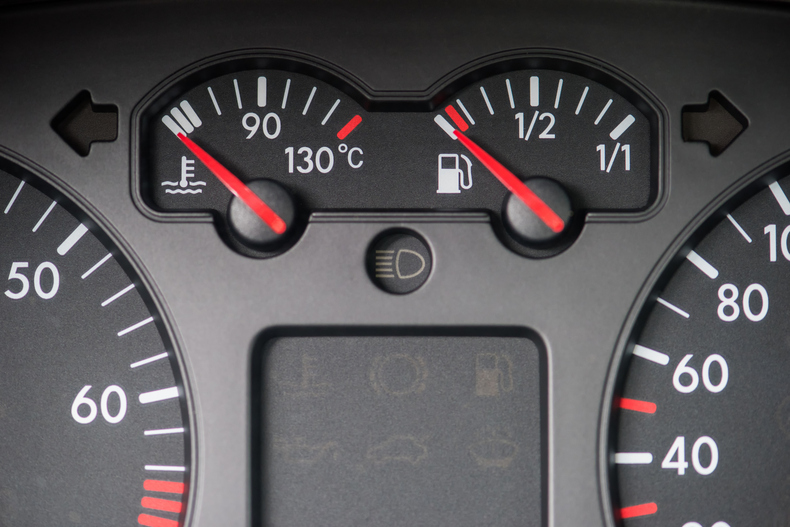
You might notice smoke rising from your vehicle without the engine overheating. Although this is usually triggered by minor faults, the issue can become serious if you ignore the warning signs.
The most common causes of smoke without an overheating engine are:
- Oil spillage – it’s important to use a funnel when topping up engine oil. Plastic and rubber parts can break down prematurely when submerged in the liquid over time.
- Oil leaks – rather than somebody spilling oil, leaks occur where faulty parts fail to contain or transport liquid securely.
- Oil filler caps – when fuel is burnt in some cars they can leave a dark residue. Older engines usually produce more hotspots that burn the residue as smoke.
- Faulty wires – it’s easy to recognise a smoking wire, as the faulty parts will give off a strong odour. If the problem comes from your alternator’s copper wires, the smell won’t be as strong but your car’s engine lights should turn on.
- Leaking coolant – your coolant overflow tank can leak fluid that burns and lets off steam.
Find out most popular products at RAC Shop.

RAC sale – up to 33% off*
• Roadside cover from £5.29 a month†
• We get to most breakdowns in 60 mins or less
• Our patrols fix 4/5 breakdowns on the spot


